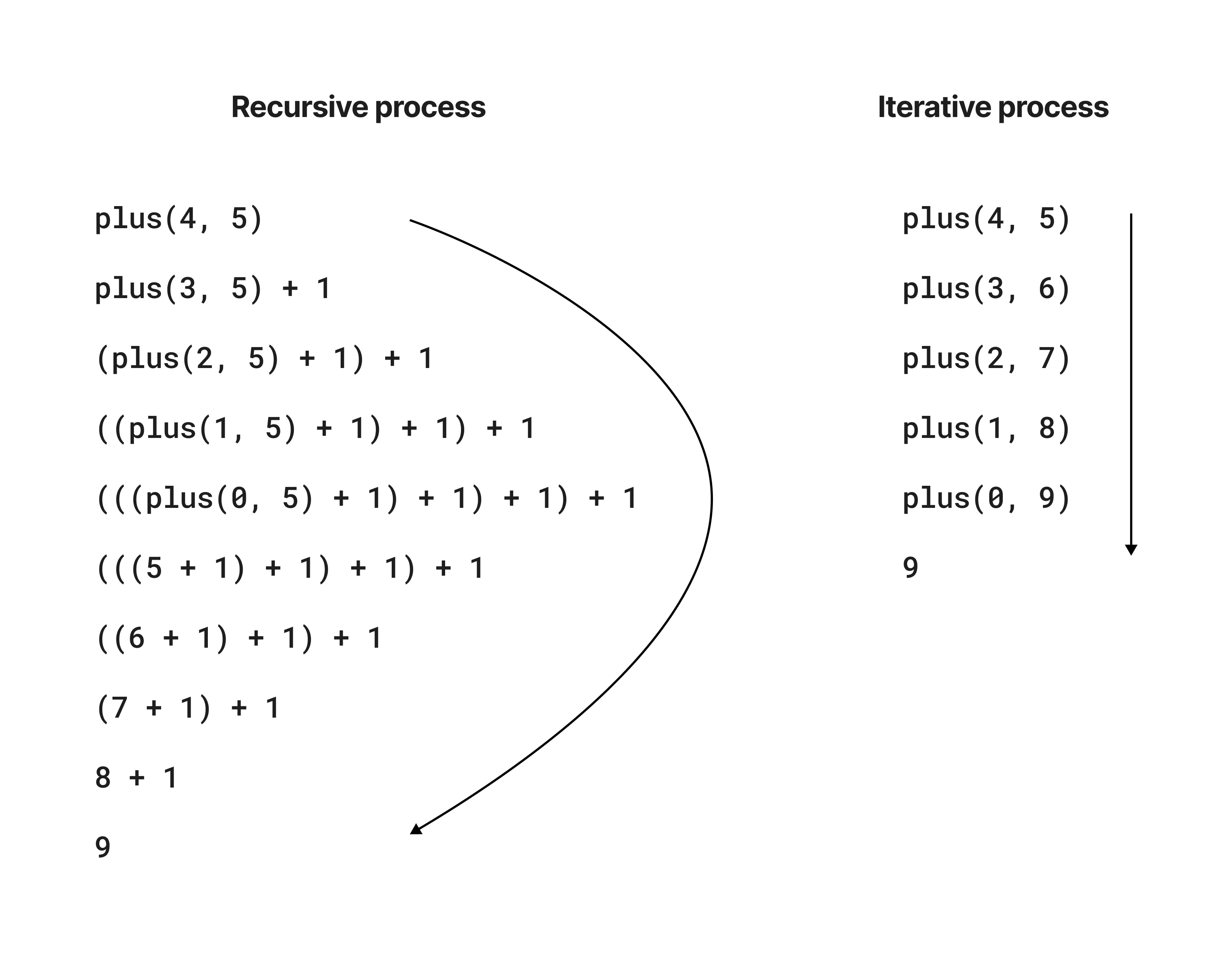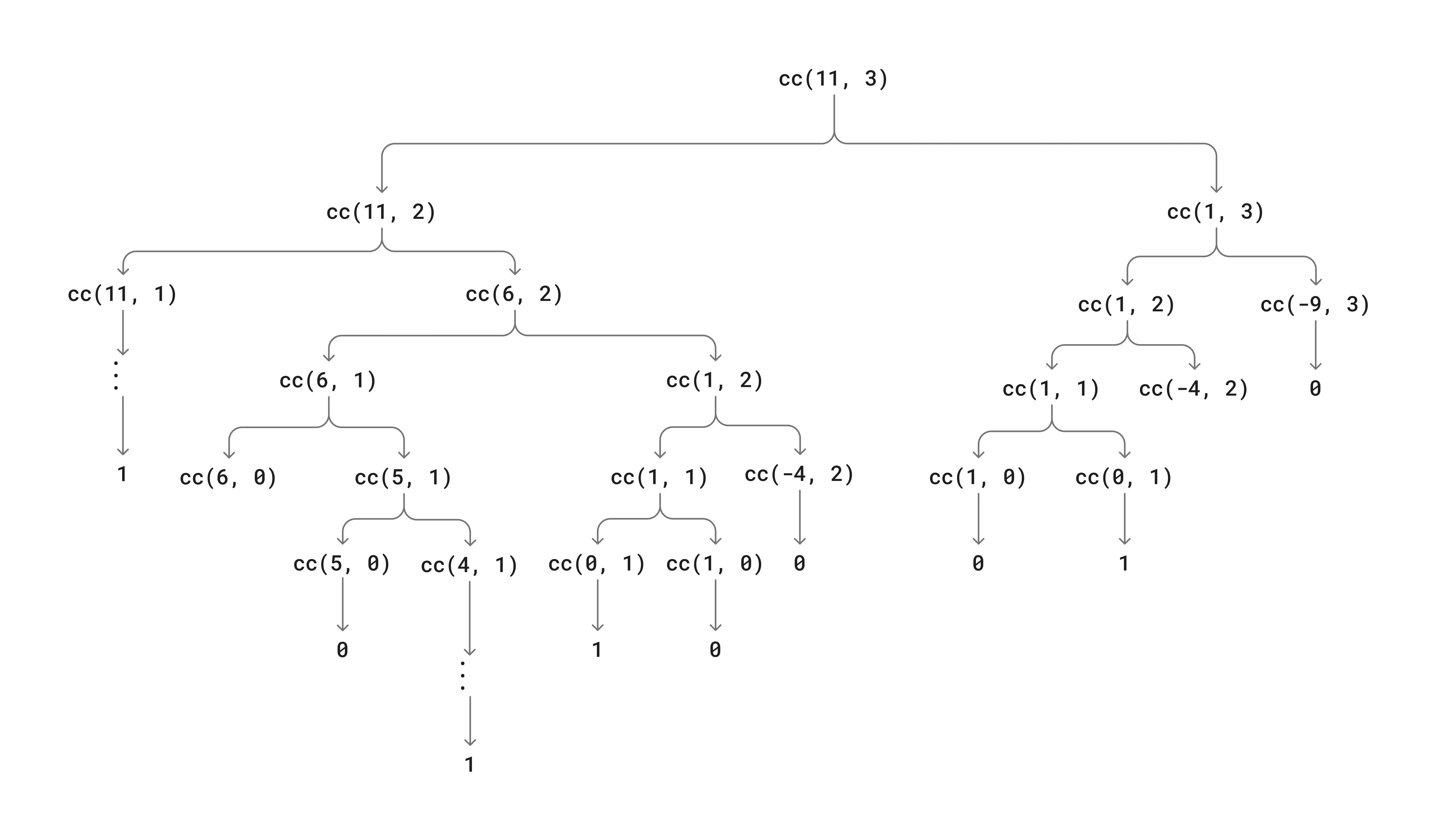Chapter 1 - Building Abstraction with Functions
1.2.1 Functions and the Process They Generate 1
Exercise 1.9
-
functions:
// Recursivefunction plus(a, b){return a === 0 ? b : inc(plus(dec(a), b));}// Iterativefunction plus(a, b){return a === 0 ? b : plus(dec(a), inc(b));}
The evaluation process of the iterative/recursive version of plus(a, b):

Exercise 1.10
The evaluation of the Ackermann’s function:
function A(x, y) { return y === 0 ? 0 : x === 0 ? 2 * y : y === 1 ? 2 : A(x - 1, A(x, y - 1));}
console.log("\n==========Exercise 1.10==========");console.log("The result of A(1, 10): ", A(1, 10));console.log("The result of A(2, 4): ", A(2, 4));console.log("The result of A(3, 3): ", A(3, 3));output:
==========Exercise 1.10==========The result of A(1, 10): 1024The result of A(2, 4): 65536The result of A(3, 3): 65536Mathematical definitions for the provided functions:
-
function 1:
function f(n) { return A(0, n); }The math expression of
f(n)is: -
function 2:
function g(n) { return A(1, n); }Function expansion:
A(1, n)A(0, A(1, n - 1)) = 2 * A(1, n - 1)2 * A(0, A(1, n - 2)) = 2 * 2 * A(1, n - 2)...2 * 2 * 2 * 2 * ... * A(1, 0) = 2 * 2 * 2 * 2 * ... * 2Therefore, the math expression of
g(n)is: -
function 3:
function h(n) { return A(2, n); }Function expansion:
A(2, n)A(1, A(2, n - 1)) = 2 ** (A(2, n - 1))2 ** 2 * (A(1, n - 2)) = 2 ** (2 ** A(2, n - 2))...2 ** (2 ** (2 ** (2 ** (...** (2 * 0)...))))Therefore, the math expression of
h(n)is: -
function 4:
function k(n) { return 5 * n * n; }The math expression of
k(n)is:
Exercise 1.11
The JavaScript version of the math function in both recursive and iterative methods
//recursive methodfunction fr(n) { return n < 3 ? n : fr(n - 1) + 2 * fr(n - 2) + 3 * fr(n - 3);}
//iterative methodfunction fi(n) { return fi_iter(2, 1, 0, n);}function fi_iter(a, b, c, n) { return n === 0 ? c : n === 1 ? b : fi_iter(a + 2 * b + 3 * c, a, b, n - 1);}
console.log("\n==========Exercise 1.11==========");console.time("f(n) recursive method total time: ");console.log("result of f(20) recursive method: ", fr(20));console.timeEnd("f(n) recursive method total time: ");console.time("f(n) iterative method total time: ");console.log("result of f(20) iterative method: ", fr(20));console.timeEnd("f(n) iterative method total time: ");output:
==========Exercise 1.11==========result of f(20) recursive method: 10771211f(n) recursive method total time: : 1.574msresult of f(20) iterative method: 10771211f(n) iterative method total time: : 0.529msExercise 1.12
Pascal’s triangle:
function pascalTriangle(row, col) { return col === 0 || col === row ? 1 : pascalTriangle(row - 1, col - 1) + pascalTriangle(row - 1, col);}
// Helper function to print out the pascal triagnlefunction printPascalTriangle(n) { const totalPad = n - 1; for (let row = 0; row < n; row++) { let str = "".padStart(totalPad - row, " "); for (let col = 0; col < row + 1; col++) { str += pascalTriangle(row, col); str += " "; } console.log(str); }}
console.log("\n==========Exercise 1.12==========");console.log("A pasccal triangle with 5 rows:");printPascalTriangle(5);output:
==========Exercise 1.12==========A pasccal triangle with 5 rows: 1 1 1 1 2 1 1 3 3 11 4 6 4 1Exercise 1.13
Step 1
We assume that , and the recursive format of can be expressed as:
Assuming that , we divide both sides by , and get:
Given that in the quadratic formula :
We can solving the equation:
Then we can denote each solution as:
Step 2
The Fibonacci sequence if a linear homogeneous recurrence relation of the second degree, its general solution is a linear combination of the solutions found:
For and , we can find the values of and :
Step 3
Now we subsitute and back into the general solution:
With n increasing, will gradually approaching 0, therefore is the closest integer to
Exercise 1.14
The tree-recursive process generated in computing count_change(11) function:

The step has order of growth, where is the target amount; The order of growth of the space is , where is the target amount and is the number of coin dominations, because each combination of amount and coin denomication is calculated only once.
Exercise 1.15
Compute the sine value of an angle:
let runCounts = 0;
function cube(x) { return x * x * x;}
function p(x) { runCounts += 1; return 3 * x - 4 * cube(x);}
function sine(angle) { return !(Math.abs(angle) > 0.1) ? angle : p(sine(angle / 3));}
console.log("\n==========Exercise 1.15==========");console.log(sine(3.14));console.log( "The total time of the function p runs when evaluation sine(3.14) is: ", runCounts);output:
==========Exercise 1.15==========0.0008056774674223277The total time of the function p runs when evaluation sine(3.14) is: 4The number of steps of sine(angle) is , where is the angle, and is the precision;
The space complexity is also , reflecting the depth of the recursive calls.
Exercise 1.16
The iterative version of the fast-exponentiation algorithm:
function fastExptIter(b, n) { if (n === 0) return 1; a = 1; while (n > 0) { if (n % 2 === 1) { a *= b; n -= 1; } else { b *= b; n /= 2; } } return a;}
console.log("\n==========Exercise 1.16==========");console.log( "Our result of 2^5: ", fastExptIter(2, 5), "; Correct answer", 2 ** 5);
console.log( "Our result of 3^8:", fastExptIter(3, 8), "; Correct answer", 3 ** 8);
console.log( "Our result of 4^11:", fastExptIter(4, 11), "; Correct answer", 4 ** 11);output:
==========Exercise 1.16==========Our result of 2^5: 32 ; Correct answer 32Our result of 3^8: 6561 ; Correct answer 6561Our result of 4^11: 4194304 ; Correct answer 4194304Exercise 1.17
A faster version of times(a, b) function with complexity:
function double(a) { return a * 2;}
function halve(b) { return b / 2;}
function fastTimes(a, b) { return b === 0 ? 0 : b % 2 == 1 ? a + fastTimes(a, b - 1) : fastTimes(double(a), halve(b));}
console.log("\n==========Exercise 1.17==========");console.log( "Our result of 5 * 9:", fastTimes(5, 9), "; Correct answer: ", 5 * 9);console.log( "Our result of 423 * 12:", fastTimes(423, 12), "; Correct answer: ", 423 * 12);output:
==========Exercise 1.17==========Our result of 5 * 9: 45 ; Correct answer: 45Our result of 423 * 12: 5076 ; Correct answer: 5076Exercise 1.18
The iterative version of the fastTimes(a, b):
function fastTimesIter(a, b) { let ans = 0; while (b > 0) { if (b % 2 === 1) { ans += a; b -= 1; } else { a = double(a); b = halve(b); } } return ans;}
console.log("\n==========Exercise 1.18==========");console.log( "Our result of 5 * 9:", fastTimesIter(5, 9), "; Correct answer: ", 5 * 9);console.log( "Our result of 423 * 12:", fastTimesIter(423, 12), "; Correct answer: ", 423 * 12);output:
==========Exercise 1.18==========Our result of 5 * 9: 45 ; Correct answer: 45Our result of 423 * 12: 5076 ; Correct answer: 5076Exercise 1.19
Applying the transformation matrix in computing fibonacci numbers to achieve complexity. This exercise is a bit tricky, please refer to Kaldewaji 1990, page 88 for the details of the expressions of the transformation matrix:
// 1.19function fib(n) { return fibIter(1, 0, 0, 1, n);}
function fibIter(a, b, p, q, count) { return count === 0 ? b : count % 2 === 0 ? fibIter(a, b, p * p + q * q, p * q + p * q + q * q, count / 2) : fibIter(b * q + a * q + a * p, b * p + a * q, p, q, count - 1);}
console.log("\n==========Exercise 1.19==========");console.log("Result of faster fib(3): ", fib(3));console.log("Result of faster fib(10): ", fib(10));console.log("Result of faster fib(20): ", fib(20));output:
==========Exercise 1.19==========Result of faster fib(3): 2Result of faster fib(10): 55Result of faster fib(20): 6765